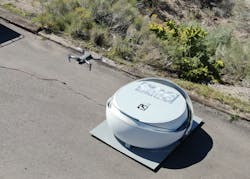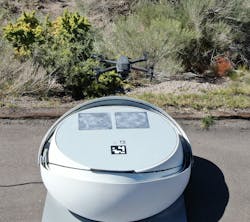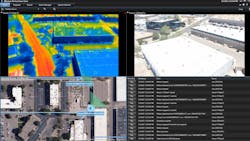Vanguard Award Honorable Mention: Drones on Patrol
This article also appears in the November 2021 issue of Security Business magazine.
The University of New Mexico (UNM) is one of the largest employers in the state and has a footprint that includes a nearly 800-acre campus near Route 66 in Albuquerque, as well as a variety of other properties located in municipalities throughout the state. Having responsibly for such a large swath of real estate, the university and its police force face a challenge all too familiar to higher education institutions across the country – how to cover such a massive area with limited resources.
According to Craig Kief, Director of UNM’s COSMIAC Research Center, the school recently decided to sell a former housing building for international students in the city, located about a mile and half from the main campus, and subsequently vacated the four-acre parcel in anticipation of a transaction. However, with the onset of the COVID-19 pandemic, the sale of the property became indefinitely delayed, and university leaders feared the building may become occupied by squatters or targeted by vandals or copper thieves. Although they had several surveillance cameras installed on street corners outside the building, Kief says they needed a more robust solution.
“What they needed was a way to routinely have a presence and visibility in the air, as well as a capability, on demand, to deploy out as a possible deterrent,” Kief explains. “In New Mexico, one of the big problems we have are copper thieves: People will back up with a truck to a facility, take a chain out, throw it around the cable and drive away. The damage is horrific when it happens, so they were afraid of that; additionally, this could be a squatters heaven and we needed a way to be able to make sure that people were not getting in there and setting up a house, meth den or something else.”
Because the property is in a congested area, Kief says if they were alerted to an event that required a police response, it would still take between five to 10 minutes for them to arrive – and that is even if they have an officer available – which further necessitated a solution that could be remotely deployed.
The Solution
To get the project off the ground, UNM officials turned to Utah-based Counter Drone, which was founded in 2015 with the goal of helping the military, as well as private and public sector organizations mitigate the threats presented by malicious UAV operators. Shaun Jafarian, the Founder and Chief Technology Officer for Counter Drone, says they proposed leveraging a pair of drones to watch over the property that would be housed in charging domes on rooftops at the UNM main campus, where they could be launched at a moment’s notice.
Jafarian adds that the drones, which are a combination of a proprietary UAV built by Counter Drone and commercially available ones from DJI, have two modes of operation: The first is a launch triggered by motion detection on a surveillance camera or door sensor; the second is a pre-planned mission mode in which the drone will launch on its own at a pre-determined time to fly around an area of interest. Jafarian says these modes can also be combined, enabling them to have one UAV slotted for pre-planned missions, while the other responds to active security events. Though they have a total of eight drones that could be flown at given time, currently there is only one that is alert ready.
When presented with the capabilities that security drones could offer – which also include the ability to deliver audio messages via a loudspeaker to people on the ground, in addition to bird’s eye surveillance – Kief says university police were awestruck.
“The minute that Counter Drone was able to show them even a rudimentary capability they said, ‘This is so much better than what we have – we want it,’” Kief says. “The hurdles were technical; they weren’t managerial or procedural. The police instantly saw this is a no-brainer.”
The Challenges
“Any time a craft is in the air, we are the responsible parties; in fact, the name of one of our engineers is associated with the launches in the FAA database,” Jafarian says. “That’s how the FAA requires it to be done, because they must have someone they consider to be the pilot.”
Jafarian says he hopes one day to be able to be able to turn over total ownership to university police, but that right now Counter Drone is maintaining all the infrastructure – video storage, servers, etc. – while still allowing authorities access in real time.
“It is my belief that it should belong to the site owner, but because right now responsibility for flying the craft remains on our shoulders, we are maintaining the video as well, so these are regulatory questions that need to get sorted out sooner rather than later,” Jafarian says. “The fact is, there’s nobody else doing this in the wild, so we are paving the way.”
The Integrator’s Role
Aaron Simpson, President and Chief Technology Officer of Utah-based security integrator Stone Security, which helped tie the Counter Drone solution into the Milestone platform, says this is one the first projects they have worked on where drones were used as actual surveillance tool.
While many organizations have placed an emphasis on mitigating the threats posed by drones as they have become more widely available to consumer in recent years – in the form of Counter-UAS (C-UAS) technology – Simpson says that projects like the one at UNM will also go a long way in shaping how the industry views them as a technology resource.
“If you are able to bring [a drone] in as an asset alongside every other camera [an end-user] has in their system, that certainly helps,” Simpson says. “The other piece is having it be drone-agnostic. Even though they have their own drone that is capable of more, I think the fact that [Counter Drone] is pulling in these DJI drones is significant as well. Sometimes people just want to know they are not locked in.”
The Future
Once the Counter Drone team installs the charging domes at the Science & Technology Park, Jafarian says they plan to start flying day missions on the premises with night missions to follow after the solution has proved its viability there. According to Kief, UNM is also evaluating the project for future expansion.
“I am convinced that this is going to take off exponentially here in the coming months, just because of the added value,” Jafarian says. “Ultimately, our goal was to reduce workload for security operators, and this also has the potential to take people out of harm’s way. You do not necessarily need a human on the ground engaging with a potentially dangerous suspect when this [UAV] can be on scene faster, giving you eyes and one-way communication.”
Joel Griffin is Editor-in-Chief of SecurityInfoWatch.com. Read about the other Vanguard Award projects at www.securityinfowatch.com/vanguard.




!['Our goal was to reduce workload for security operators, but this also has the potential to take people out of harm’s way. You do not necessarily need a human on the ground engaging with a potentially dangerous suspect when this [UAV] can be on scene faster.” — Shaun N. Jafarian, founder and CEO, Counter Drone 'Our goal was to reduce workload for security operators, but this also has the potential to take people out of harm’s way. You do not necessarily need a human on the ground engaging with a potentially dangerous suspect when this [UAV] can be on scene faster.” — Shaun N. Jafarian, founder and CEO, Counter Drone](https://img.securityinfowatch.com/files/base/cygnus/siw/image/2021/10/Shaun_N._Jafarian.61770f7b80c39.png?auto=format,compress&fit=max&q=45&w=250&width=250)
![“These drones are a huge asset because you have the ability to run tours out to areas that may not typically get coverage. It really allows you to expand this kind of virtual infrastructure to cover areas around [remote] facilities.” -Aaron Simpson, Stone Security “These drones are a huge asset because you have the ability to run tours out to areas that may not typically get coverage. It really allows you to expand this kind of virtual infrastructure to cover areas around [remote] facilities.” -Aaron Simpson, Stone Security](https://img.securityinfowatch.com/files/base/cygnus/siw/image/2021/10/Simpson.6171b26bba539.png?auto=format,compress&fit=max&q=45&w=250&width=250)



